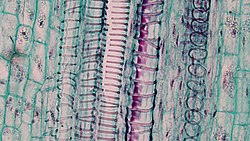Woody Dicot Stem Four Year Sambucus (35837215284)
cross section: Sambucus stem magnification: 100x
During the first year of growth the epidermis is stretched laterally by the expansion of secondary xylem, phloem and cambium. The epidermis is replaced by a protective secondary zone of cork rich periderm. Continual growth of the periderm keeps up with that of underling tissues allowing it to replace the functions of the degrading epidermis.
The outermost layer of periderm consists of layers of cork cells, the phellem, which produce the waterproofing substance suberin. Cork cells are dead at maturity. Deep to the phellem is a layer of living green stained cork cambium or phellogen and just beneath that layers of cork parenchyma or phelloderm. Many cells in the periderm contain dark staining tannins.
In certain areas the cork cambium over produces cork cells, resulting in the formation of ridges and deep cracks in the periderm. These deep fissures, or lenticels, permit gas exchange with tissues under the periderm.
Deep to the periderm is an outer cortex of tightly packed lamellar collenchyma and an inner cortex of open airy parenchyma. Large dark staining tannin ducts are present.
The vascular cylinder consists of a narrow outer of primary and secondary phloem, a middle ring of vascular cambium and a deeper large ring of primary and secondary xylem. Phloem bands of sieve tubes and companion cells are layered and interspaced with parenchyma cells masses and occasional small bundles of sclerenchyma cells. Small masses of calcium oxalate crystals are present. Xylem is separated from the pith by a starch sheath of dark staining parenchyma cells.
The vascular cylinder is divided into narrow columns by radial bands of parenchymatous rays that extend from pith to phloem. Wide phloem rays taper as they dip into the xylem where they merge with the starch sheath. A large parenchymatous pith occupies the center of the stem.
Dark staining tannin producing cells are present throughout the stem including the pith.Relevantní obrázky
Relevantní články
StonekStonek je vegetativní orgán cévnatých rostlin a společně s kořeny a listy představuje hlavní stavební jednotku rostlinného těla. Charakter stonku a způsob jeho větvení určuje růstovou formu rostliny, tedy jedná-li se o strom, keř, bylinu, liánu a podobně. Stonek nese nad zemí listy a reprodukční orgány, pod zemí kořeny. Mimo to může plnit i řadu různých dalších funkcí. U většiny jednoděložných rostlin je stonek bylinný, u jehličnanů a většiny dvouděložných je druhotně tloustnoucí a více či méně dřevnatý. .. pokračovat ve čtení
















